Accelerating Innovation and
Building Unshakable Customer Loyalty

For software and technology companies, customer feedback isn’t confined to a single channel. It’s a constant data stream flowing through surveys, reviews, in-product interactions, and across your website.
The challenge? Feedback is often fragmented across multiple touchpoints and systems, making it difficult to see the full picture and understand customer sentiment.
Without a unified, omnichannel approach to customer feedback, product teams risk making decisions in the dark, customer success teams struggle to understand churn, and marketing teams miss opportunities to optimize customer experiences.
In this guide, we’ll explore:
Let’s dive in!
To truly understand and improve customer experiences and software products, tech companies require a variety of feedback channels. An omnichannel approach enables tech companies to drive innovation, build great products, and better understand and address customer needs.
These surveys provide structured, quantifiable data that tech companies use to make informed decisions about product development and feature prioritization. Surveys are invaluable as they provide a structured method for gathering specific insights that directly inform product innovation and CX enhancements.
In-product feedback is essential for tech companies, providing real-time insights into customer sentiment that drive rapid iteration and continuous improvement. This immediate feedback loop is critical in the fast-paced tech industry, where user experience makes or breaks an app or product’s success.
Embedded feedback tools on websites are essential for tech companies to continuously refine their user interfaces and overall user experience. Feedback gathered on websites helps identify pain points in the customer journey, leading to improved conversion rates and customer satisfaction.
These tools not only provide support but also offer a wealth of data on user needs and preferences. For tech companies, this matters as it helps in personalizing user experiences and identifying areas where customer support or features may need improvement.
These platforms provide unfiltered, organic feedback that helps tech companies understand their market position and brand perception. This matters immensely in the tech industry, where reputation and word-of-mouth significantly influences adoption rates and customer loyalty.
In a mobile-first world, app store reviews are critical for tech companies to gauge user satisfaction and identify bugs or issues quickly. Ratings and reviews matter because they directly impact app store rankings and user acquisition, which are vital for success in competitive app stores.
The following scenarios highlight how software and technology companies collect feedback to solve business challenges.
These examples showcase how businesses:
Example Scenario 1
Picture an eCommerce platform that sells a wide range of consumer electronics. Despite having an impressive product catalog and competitive pricing, the company struggled with high bounce rates and user drop-offs during the shopping process. The marketing team was puzzled as to why so many potential customers were leaving the site before completing their purchases.
Using Alchemer, the marketing team gathered insights at critical touchpoints of the customer journey:
The feedback collected revealed several issues. Customers reported that they found the product categories confusing, with products often being misplaced or difficult to find. Additionally, a significant number of users abandon their cart because of the complex and lengthy checkout process, which many describe as “frustrating” or “confusing”.
Equipped with these insights, the marketing team collaborates with the web development and UX teams to optimize the product categorization and streamline the checkout process, ultimately reducing the friction points leading to cart abandonment.
Alchemer provides powerful yet intuitive targeting features to ensure surveys and interactions reach the right customers at the right time and place.
Targeting is broken into three key areas:


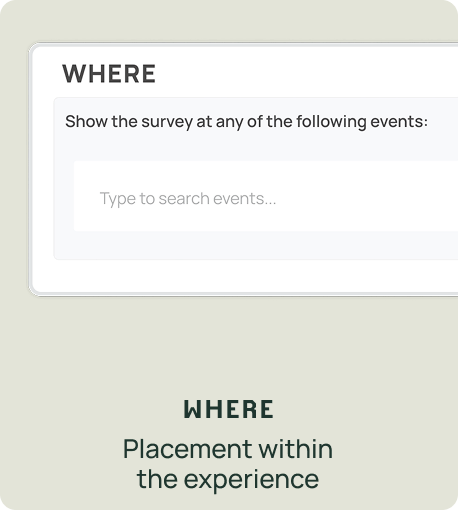
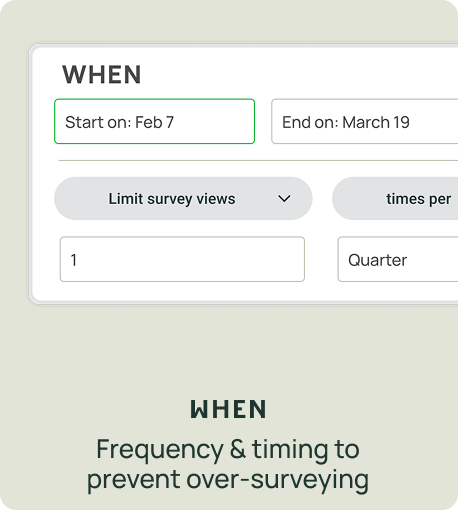
Example Scenario 2
Imagine a software company developing a project management platform. The product team is faced with an important decision: What feature should they build next? Should they improve the task management functionality, add integrations with new tools, or enhance their reporting capabilities? The company has a rough idea, but internal discussions and team opinions don’t provide enough clarity about what will actually resonate with customers.
The team relies primarily on Net Promoter Score (NPS) surveys to gauge customer sentiment. These surveys have delivered valuable insights, but they don’t give enough detail on what specific features should be prioritized.
While the NPS scores indicate overall customer happiness, it leaves the team wanting more detailed, targeted, and actionable feedback. They realize that they need a more robust feedback collection strategy to validate their ideas.
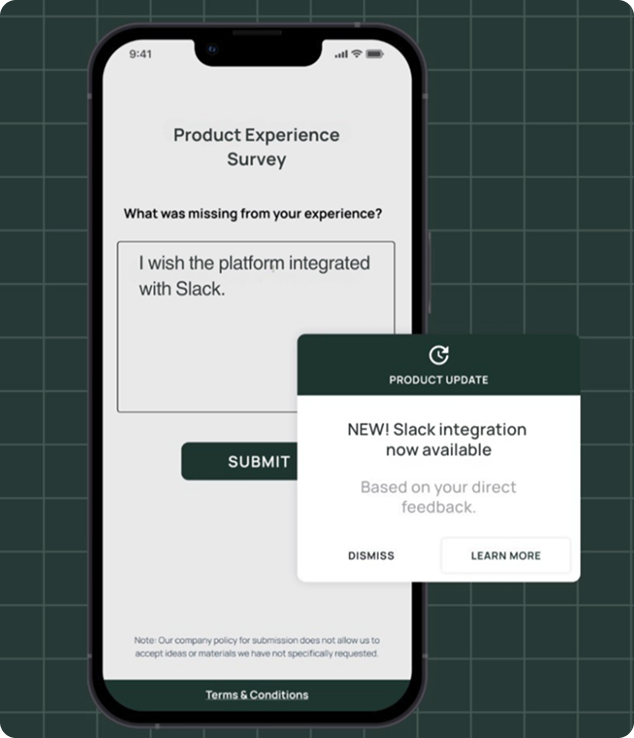
Real-time surveys target specific user segments, such as power users or new customers, and collect detailed feedback on their pain points, desired features, and overall experience with the platform. This helps the team identify the most pressing needs across different user groups.
Digital Prompts engage users at key moments, such as after completing a project or using a specific feature. These prompts ask users to rate their experience, suggest improvements, or share feedback on new or existing features. For example, a prompt might ask, “How easy was it to integrate your project with your other business systems?” or “Do you find the task dependencies feature intuitive?”
Social media monitoring allows the team to listen to real-time conversations about the product across platforms like X, LinkedIn, and Facebook. By leveraging Alchemer Pulse to monitor user sentiment and discussions, they uncover additional pain points, themes, and requests that might not be captured through formal surveys.
With feedback collected across these diverse channels, the product team gains a much clearer picture of customer preferences. For example, they discover that many users are requesting integrations with popular tools like Slack, while others are asking for enhanced task dependencies in the project management interface.
Armed with this rich, multi-source feedback, the team can confidently make decisions about which features to prioritize in upcoming releases, ensuring the product roadmap reflects actual customer demand.
A customer-validated product roadmap: A roadmap shaped by direct customer feedback, ensuring that product development is aligned with the features most in demand, resulting in a product that truly meets user needs.
Higher customer retention: As features are rolled out based on actual demand, customers experience greater satisfaction, leading to stronger retention and ongoing product adoption.
Faster product updates: Real-time, actionable insights drive faster, data-backed product updates, allowing teams deliver meaningful improvements at an accelerated pace.
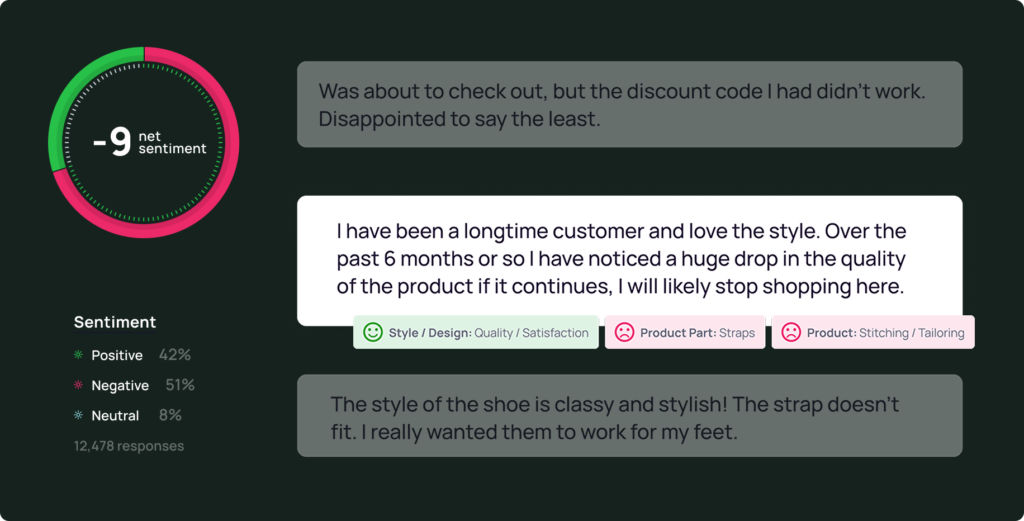
With feedback coming from surveys, digital prompts, and social media, product teams need an analysis tool to cut through the noise. Alchemer Pulse uses AI to analyze open-text feedback in real time, highlighting key trends, and helping teams prioritize feature requests based on customer sentiment.
Custom dashboards, real-time sentiment tracking, and automated alerts help teams quickly act on insights, ensuring product decisions align with actual customer needs.
Example Scenario 3
A SaaS company that builds and sells marketing automation software faced a sharp rise in churn. The customer success team struggled to pinpoint the exact reasons users are leaving. While they had general feedback from sales calls and support tickets, they didn’t have specific data to inform a retention strategy.
After analyzing exit survey results, they found that many users feel the platform is difficult to navigate, especially for new users, and others complained about the lack of customization in the reporting tools. By looking at the CSAT surveys and feedback from targeted in-app prompts they also noticed that customers who have trouble setting up their first campaign or creating workflows tend to rate their experience lower.
This feedback enabled the Customer Success team to pinpoint key pain points in the user experience and leverage those insights to enhance retention strategies.
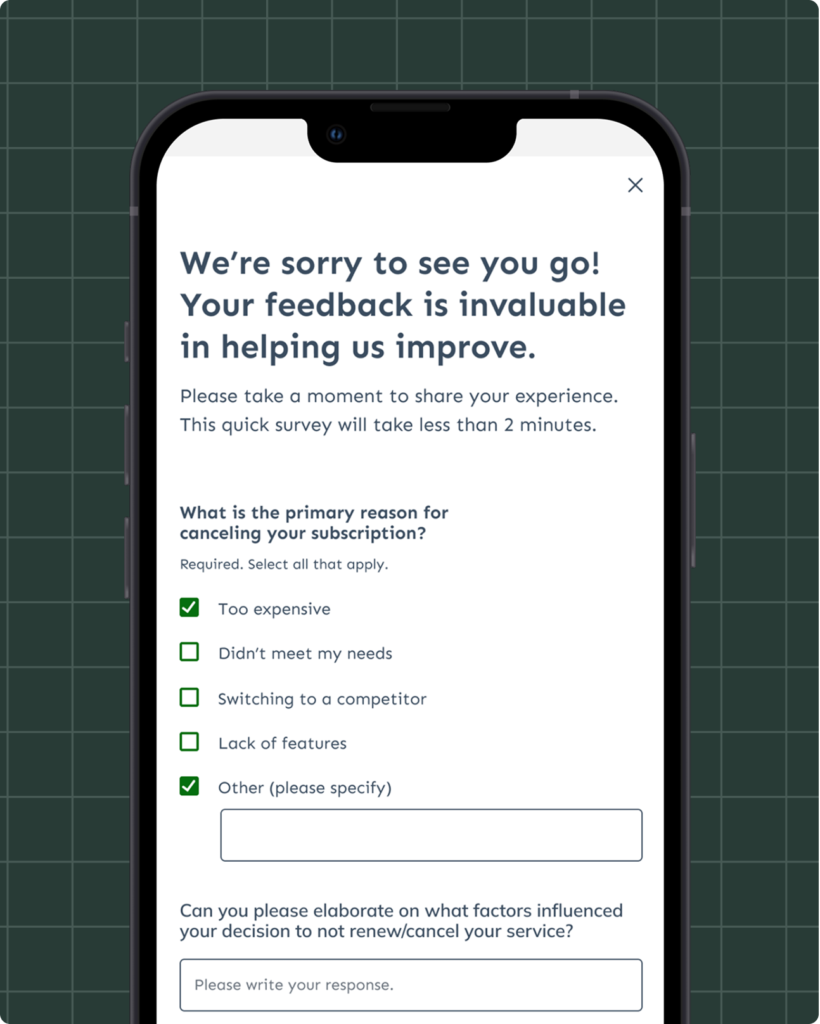
Impactful, actionable customer feedback programs are no longer just theoretical—they are driving real business results every day. This is evident in the following stories, where industry leaders FanDuel and Malwarebytes leveraged customer feedback to achieve measurable success and drive their businesses forward.

FanDuel, a leader in the world of fantasy sports and mobile sports betting, faced a unique challenge as they rapidly expanded their app into new states. With over 12 million registered customers, it was crucial for them to continue growing in a competitive market while ensuring their marketing efforts targeted the right customers.
To optimize their mobile marketing programs, FanDuel turned to Alchemer to help collect mobile customer sentiment data. They used these insights to tailor their marketing strategies and improve customer engagement across multiple channels.


Malwarebytes, a global leader in cybersecurity, needed a robust and reliable customer feedback platform to support multiple departments.
To scale their CX efforts, Malwarebytes turned to Alchemer. Malwarebytes currently conducts NPS surveys for 30,000 consumer customers each month and 500 business customers and they’ve seen several key outcomes from using Alchemer:

Choosing the right customer feedback platform is a pivotal decision that will shape how your software or tech company understands and responds to your customers. Purchasing a CX platform involves careful research and asking the right questions.
To get the most value from your investment, here are the key elements to consider:
A platform that allows you to collect feedback across multiple channels ensures you’re capturing customer sentiment wherever your users interact with your brand—whether through mobile apps, in-app surveys, website feedback, or social media. A unified feedback system boosts operational efficiency, reduces costs, and supports more informed decision-making.
Your customer feedback platform should integrate seamlessly with other business systems, such as CRM software, marketing automation tools, and sales analytics platforms. A platform that supports APIs and integrates with popular third-party tools like Salesforce, Shopify, Slack, and Zendesk simplifies data flow across systems, eliminating manual processes.
A smooth and quick implementation process is essential for maximizing the potential of a new CX platform. Evaluate how simple it is to set up, integrate, and customize the platform to fit your company’s needs. Look for a user-friendly interface that minimizes the learning curve for your team. Also, consider the level of support the vendor provides during onboarding, training, and ongoing use.
Data security is crucial when handling sensitive customer information, such as personal data or payment details. Look for a platform with strong data encryption and compliance with regulations like GDPR and CCPA, which helps maintain customer trust and protect privacy. Transparent security protocols are important not only for legal compliance but also for preventing potential data breaches.
For software and technology companies, customer feedback is more than just data—it’s the foundation for making the right decisions that drive product innovation, improve retention, and optimize digital experiences.
Alchemer provides the tools to seamlessly collect, analyze, and act on customer insights across every touchpoint. Whether refining a product roadmap, reducing churn, or enhancing user experience, a comprehensive, omnichannel feedback strategy ensures the customer is placed at the center of every business decision.
Alchemer has decades of experience helping brands turn feedback into action.
For software and technology companies, customer feedback isn’t confined to a single channel. It’s a constant data stream flowing through surveys, reviews, in-product interactions, and across your website.

We hear it every day: federally funded organizations are on edge. Budgets...

For businesses operating across multiple locations, customer feedback is a crucial asset...
Please provide your name and email to continue reading.